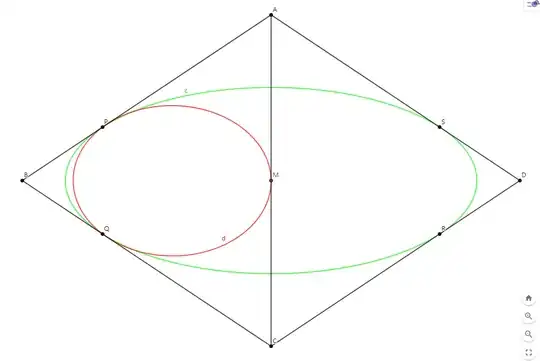The Steiner Ellipse is an ellipse inscribed in a triangle, where the ellipse goes through all three midpoints of the triangle. It is also known as the maximum area inellipse of a triangle.
See here for Marden's Theorem : Link
and here for Siebeck-Marden Theorem : Link.
I'm a highschool student working on the Steiner ellipse, and my team did manage to prove Marden's Theorem and many other stuff for parallelograms in an elementary method, without the use of transformations and stuff.
My team is recently working on the expansion of Siebeck-Marden Theorem into parallelograms, and found a conjecture that the ratio of Area(d)/Area(c) is constant. (Picture below : BP : PA = BQ : QC = DS : SA = DR : RC = m : n and M is the midpoint of AC. c is the green ellipse inscribed in ABCD, tangent in P, Q, R, S, and d is the red ellipse inscribed in ABC, tangent in P, Q, M.)
We proved that the ratio of the area of the green ellipse and the area of the parallelogram is equal to the following formula : $$\frac{S_c}{S_{ABCD}} = \frac{\pi}{2} \sqrt{k(1-k)}$$
where $k = \frac{n}{m+n}.$ (The formula above is when each side of the parallelogram is internally divided in $1 : k$.)
You can check that this formula does work by letting $k = \frac{1}{2}$; then the ratio becomes $\frac{\pi}{4}$ and this is the Steiner Ellipse for Parallelograms.
The ratio seems to result in $\frac{2}{3 \sqrt{3}}$ by guess, and we checked for 5 different cases in Geogebra.
$$\text{Ratio} = \frac{\text{Area}(c)}{\text{Area}(d)} \approx 0.39$$
The result is not that correct since we did not construct the ellipse, but drew it by hand(which is an approximation.). The result is still very close to the guess.
Is there a paper about these expansions into parallelograms? I found Alan Horwitz's work though. Also since we're working on a paper, it would be better if paper proofs or hints are exhibited. (It is quite difficult to put an answer in a Q&A site as reference, and it is immoral to offer as if I proved it.)
This is just a guess, so it might be false if computed correctly. Any help would be appreciated.

